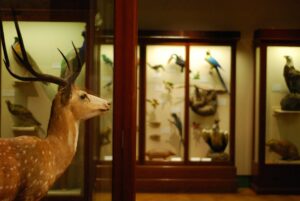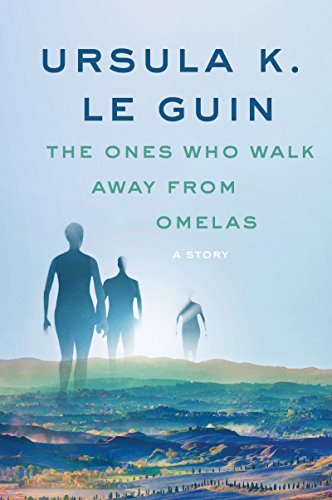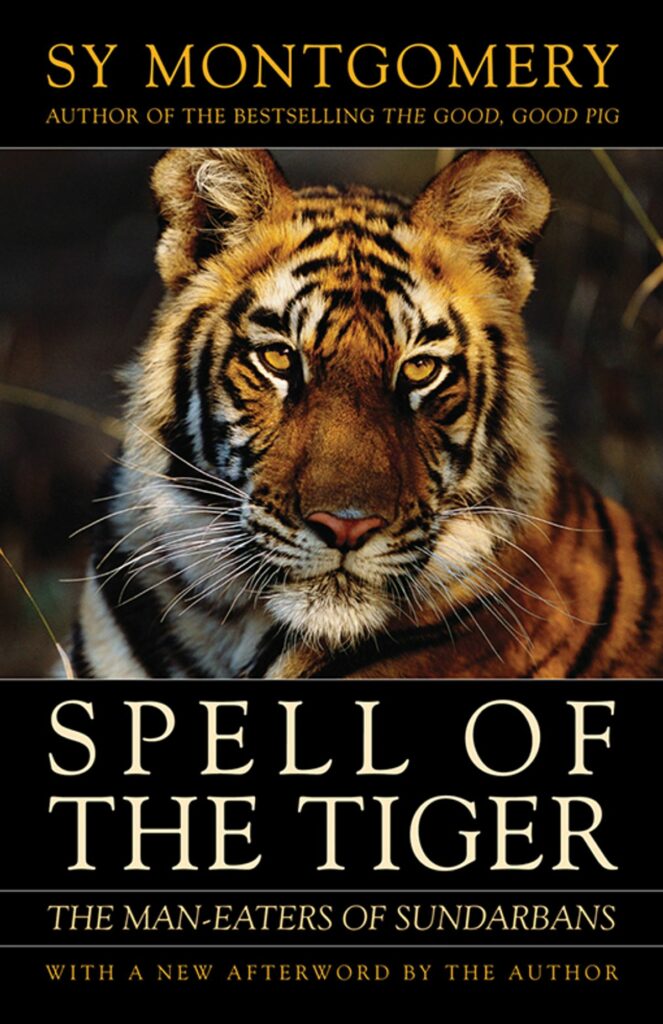This is the third and final part of a series on teaching ecohorror curated and introduced by Christy Tidwell. (Read Part 1 and Part 2, too, and check out Fear and Nature: Ecohorror Studies in the Anthropocene for much more on ecohorror.)
As the previous posts about teaching ecohorror indicate, ecohorror exists as a distinct horror subgenre with key texts to represent it. However, its effects and ideas can also be found in texts that aren’t obviously or only ecohorrific. And ecohorror can also be taught in a wide range of classes, even those that aren’t focused on the topic. The entries in this final post emphasize this broader context, looking to dystopian science fiction, poetry, and nonfiction as opportunities to address and sources of ecohorror.

From the taxidermic collections of Bristol City Museum and Art Gallery.
One example of ecohorror outside of explicitly ecohorrific narratives that has worked well for me in a variety of courses is taxidermy. Taxidermy has its own fascinating history (I recommend Rachel Poliquin’s beautiful The Breathless Zoo: Taxidermy and the Cultures of Longing) and exists in a variety of forms, including museum taxidermy, hunting trophies, Victorian entertainment, and contemporary art. Each of these depends upon animal death and the manipulation of a dead body – or at least parts of it – to tell some kind of narrative. Some taxidermy points to the horrific ways that animals and the natural world are treated. Some taxidermy asks us to think critically about our relationship with the natural world. All taxidermy challenges easy divisions between human and nonhuman, life and death, subject and object. Taxidermy has provided an interesting way for me to discuss the ideas of ecohorror without simply assigning an ecohorror movie or novel, and students are frequently fascinated and horrified by the examples we consider.
This post invites you to consider the possibilities of teaching ecohorror even if your course doesn’t have space for it as a distinct topic or if you have external constraints limiting your text choices. As Kom Kunyosying, Chelsea Davis, and Keri Stevenson show here, ecohorror is in far more places than you might think.
Teaching Ursula K. Le Guin’s “The Ones Who Walk Away from Omelas” – Kom Kunyosying
Kom Kunyosying teaches writing and literature at Nashua Community College and is co-editor of a forthcoming anthology, Horror and Comics (see call for papers).
 At my two-year institution, I teach pre-selected texts in intro-level literature courses. An unexpected silver lining of this is students perceive texts as part of an assigned curriculum and not items selected by me with a pre-determined discussion agenda in mind. This helps promote a more open discussion format in which I can respond to what students bring up while still covering requisite literary concepts.
At my two-year institution, I teach pre-selected texts in intro-level literature courses. An unexpected silver lining of this is students perceive texts as part of an assigned curriculum and not items selected by me with a pre-determined discussion agenda in mind. This helps promote a more open discussion format in which I can respond to what students bring up while still covering requisite literary concepts.
One story that’s worked particularly well with this approach is Ursula K. Le Guin’s “The Ones Who Walk Away from Omelas,” because of the open-ended metaphor of a suffering child in an otherwise utopian community. In discussing “Omelas,” I ask students to find real-world examples of the placid residents of Omelas who are similarly facilitated by an abject being(s). I often put students into groups or use this as an online prompt. A great submission was Jerry Sandusky continuing to mentor children at Penn State, a beloved institution, when he’d already been caught sexually abusing minors – violations known to co-workers who decided against disturbing the status quo.
Increasingly, students bring examples related to environmental destruction, loss of habitats, and the cruelties of factory farming – raising the topic of ecohorror. Julia Kristeva’s explanation of the abject facilitates discussion of how we define the line between what we identify as human versus what is no longer human. Fingernail and hair clippings are tame initial illustrations before ramping up to more apt examples like open wounds and corpses which, according to Kristeva, evoke a reaction of horror at the loss of distinction between subject and object.
Abjection underlies the horror in Le Guin’s placing a child outside the bounds of what is treated with human regard. Relatedly, human/animal binaries illustrate how lack of humanness is used as justification for animal suffering and ecological destruction, raising discussions of whether that justification has any logical or ethical foundation. As in Omelas, most are aware of what’s happening yet choose to remain complicit to varying degrees.
Ecohorror is among the more terrifying ways to interpret “Omelas.” Through an ecological lens, extreme distinctions in the treatment and care of what is us versus what is not us are unsustainable. Animals and marginalized peoples suffer first in a world where some continue to enjoy the status quo, but consequences of environmental destruction will touch everyone. The suffering child intersects with monstrousness and horror not because of the child’s actions but because of the actions of others, over whom the child has no agency – a factor at play for most ecohorror monsters.
Teaching William E. Stafford’s “Traveling through the Dark” – Chelsea Davis
Chelsea Davis holds a PhD in English literature from Stanford University and writes about horror fiction and film. For more, visit her website or find her on Twitter (@UnrealCitoyenne).
I taught William E. Stafford’s poem “Traveling through the Dark” (1962) as a TA for an introductory poetry course a few years ago, and was impressed by my undergraduates’ deep engagement with the work’s form and eco-ethical dilemma alike. What initially intrigued many of the students about Stafford’s piece was its rebuttal of the pastoral mode that many of them had assumed (either with reverence or with rolling eyes) since high school to be the only form that nature poetry can take. Although neither bloody nor maudlin, the poem’s five terse stanzas are surely closer to the grotesque than to the idyll: driving on a mountain road at night, a speaker finds a car-slain deer on the edge of the road and realizes that the animal is pregnant with a still-living fetus. The narrator nonetheless chooses to throw the doe’s corpse into a nearby ravine so that other drivers will not crash in trying to avoid her.
What also seemed engaging about this poem’s setup, for my students, was its relatability: anyone who routinely travels by car has seen roadkill and has perhaps also had the thought: humans did that. The poem thus provides an easy path into discussions of our species’ unwitting but devastating impact on the nonhuman world, and particularly into how we deal with the aspects of that devastation that are foregone conclusions. (The speaker inherits an animal death caused by someone else’s car; short of ending the global automobile industry, there’s little he can do but deal with that one corpse, knowing full well the slaughter will likely repeat itself anyway.)
The remarkable formal qualities of the speaker’s retelling of this moral quandary also provided an opportunity for the class to reflect on the way that grammar conditions our experience of a poem’s tone. When I asked my students what they observed about the poem’s punctuation, they swiftly noticed that semicolons, dashes, and excessive commas halt the poem’s flow in nearly every sentence (“the heap, a doe, a recent killing;” [6]). The class picked up on the way that these interruptions and asides telegraph the speaker’s hesitation (or “swerving,” a word he uses twice) about what he should do with the half-dead, half-living deer.
So, too, was it fruitful to lead the discussants through a tour of the poem’s ambiguous use of certain nouns and personification. When the speaker states that “to swerve might make more dead” (4, emphasis added), his omission of a specific antecedent for “dead” allows the human and the animal to become entangled in slaughter: more deer and more people will die if he doesn’t pull this corpse off the road. By the fourth stanza, the distinctions between these ontological categories have grown even blurrier, now pulling in even the machine: the wilderness “listens,” the car’s engine “purr[s],” and the whole ensemble of beings—man, vehicle, and two deer—is described as “our group.” When asked why Stafford might have made these grammatical choices, a student suggested that he was doing so to dial up the poem’s tragic irony: the speaker has clearly come to think of all of these creatures as interconnected, and yet he still sides, finally, with his own species, pushing a living deer fetus into the river to make way for more cars. A masterclass in syntactic and ethical uncertainty, “Traveling” introduces students to the subtle forms of anthropogenic discomfort encoded in ecohorror.
Teaching Sy Montgomery’s Spell of the Tiger – Keri Stevenson
Keri Stevenson is an Assistant Professor of English at the University of New Mexico-Gallup and author of several articles on kinship with animals in literature.
 Chapter 2 of nature writer Sy Montgomery’s Spell of the Tiger begins, “On a soft May night in West Bengal, when the sweet scent of khalsi flowers clung to the wet, warm darkness, when the moon shone round and white, and boatmen’s lanterns winked at one another like fireflies up and down the river, death came with an open mouth for Malek Molla.” This shift from dream-like description to life’s sudden ending typifies this book’s representation of human death in a more-than-human world and makes it an exemplar of the ecohorror texts I prefer teaching: those which affirm human relationships to horrifying environmental threats, the need to live and relate with no easy escape.
Chapter 2 of nature writer Sy Montgomery’s Spell of the Tiger begins, “On a soft May night in West Bengal, when the sweet scent of khalsi flowers clung to the wet, warm darkness, when the moon shone round and white, and boatmen’s lanterns winked at one another like fireflies up and down the river, death came with an open mouth for Malek Molla.” This shift from dream-like description to life’s sudden ending typifies this book’s representation of human death in a more-than-human world and makes it an exemplar of the ecohorror texts I prefer teaching: those which affirm human relationships to horrifying environmental threats, the need to live and relate with no easy escape.
Spell of the Tiger concerns the tigers of the Sundarbans Delta on the India/Bangladesh border, the only tigers in the world that regularly eat humans. Montgomery weaves together the terrors of man-eating predators, climate change, impending extinctions, and human poverty in the Sundarbans to create an ecohorrific narrative in which tigers are not the only hunters and humans not the only victims. My students, who are mostly first-generation, poor, and Indigenous people of the Diné (Navajo) and Zuni tribes, have always responded strongly to this text. The intractability of the Sundarbans’ problems—most of the humans have to go into the forest for firewood and food; most of the tigers have no opportunity to escape and live elsewhere—makes for a fascinating introduction to environmental problems like climate change and poaching that students may have encountered only as cloudy generalities and for an interesting comparison to problems in their own communities. Montgomery’s descriptive language and her sympathy for all those suffering in the Sundarbans make it easier for my classes to read and potentially incorporate her ideas. That Montgomery does not present a solution, but instead lives lived, also moves students beyond ideas of “bias” that often function unproductively in these debates.
Finally, the text embodies the tension that comes from trying to define monsters. For all that an outsider to the situation might cast tigers in that role, Montgomery carefully emphasizes throughout her book that the humans of the Sundarbans do not think of them this way. The horror of being eaten, the horror of climate change, and the horror of what is happening to tigers as a species mingle in an amazing book that has a place for fear, but none for hatred.
